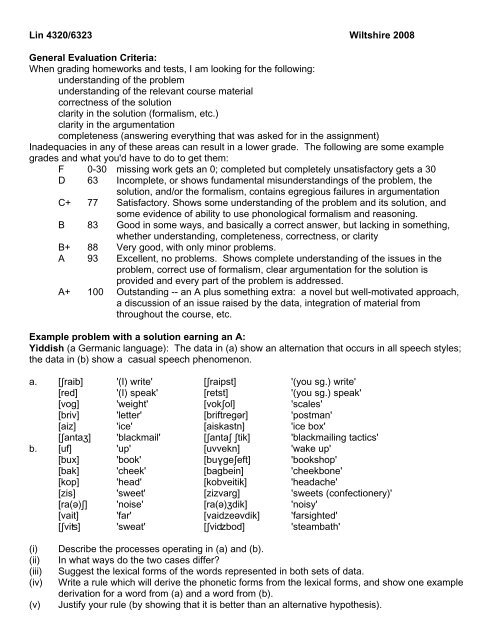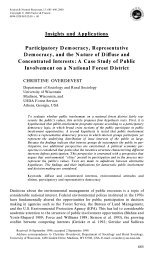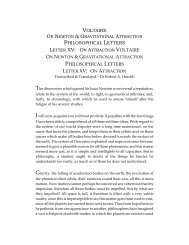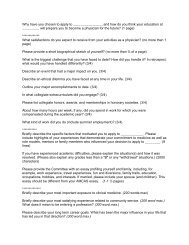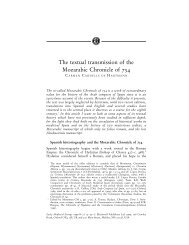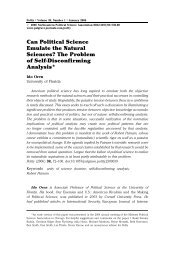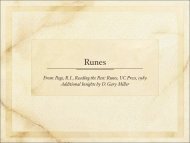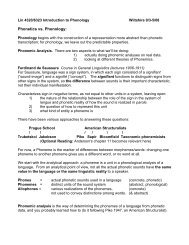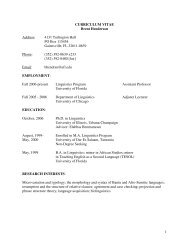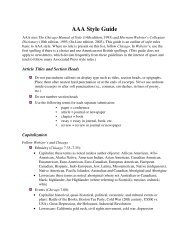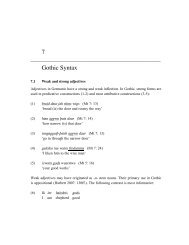Evaluation Criteria & Problem Solving
Evaluation Criteria & Problem Solving
Evaluation Criteria & Problem Solving
You also want an ePaper? Increase the reach of your titles
YUMPU automatically turns print PDFs into web optimized ePapers that Google loves.
Lin 4320/6323 Wiltshire 2008General <strong>Evaluation</strong> <strong>Criteria</strong>:When grading homeworks and tests, I am looking for the following:understanding of the problemunderstanding of the relevant course materialcorrectness of the solutionclarity in the solution (formalism, etc.)clarity in the argumentationcompleteness (answering everything that was asked for in the assignment)Inadequacies in any of these areas can result in a lower grade. The following are some examplegrades and what you'd have to do to get them:F 0-30 missing work gets an 0; completed but completely unsatisfactory gets a 30D 63 Incomplete, or shows fundamental misunderstandings of the problem, thesolution, and/or the formalism, contains egregious failures in argumentationC+ 77 Satisfactory. Shows some understanding of the problem and its solution, andsome evidence of ability to use phonological formalism and reasoning.B 83 Good in some ways, and basically a correct answer, but lacking in something,whether understanding, completeness, correctness, or clarityB+ 88 Very good, with only minor problems.A 93 Excellent, no problems. Shows complete understanding of the issues in theproblem, correct use of formalism, clear argumentation for the solution isprovided and every part of the problem is addressed.A+ 100 Outstanding -- an A plus something extra: a novel but well-motivated approach,a discussion of an issue raised by the data, integration of material fromthroughout the course, etc.Example problem with a solution earning an A:Yiddish (a Germanic language): The data in (a) show an alternation that occurs in all speech styles;the data in (b) show a casual speech phenomenon.a. [•raib] '(I) write' [•raipst] '(you sg.) write'[red] '(I) speak' [retst] '(you sg.) speak'[vog] 'weight' [vok•ol] 'scales'[briv] 'letter' [briftregcr] 'postman'[aiz] 'ice' [aiskastn] 'ice box'[•anta¥] 'blackmail' [•anta• •tik] 'blackmailing tactics'b. [uf] 'up' [uvvekn] 'wake up'[bux] 'book' [bupge•eft] 'bookshop'[bak] 'cheek' [bagbein] 'cheekbone'[kop] 'head' [kobveitik] 'headache'[zis] 'sweet' [zizvarg] 'sweets (confectionery)'[ra(c)•] 'noise' [ra(c)¥dik] 'noisy'[vait] 'far' [vaidzecvdik] 'farsighted'[•vi°] 'sweat' [•vi−bod] 'steambath'(i)(ii)(iii)(iv)(v)Describe the processes operating in (a) and (b).In what ways do the two cases differ?Suggest the lexical forms of the words represented in both sets of data.Write a rule which will derive the phonetic forms from the lexical forms, and show one examplederivation for a word from (a) and a word from (b).Justify your rule (by showing that it is better than an alternative hypothesis).
These answers were taken from a student's homework; the comments in italics (usually inparenthesis and labelled CRW) are added by Dr. Wiltshire. What I like about this answer: it'scomplete, thorough, clear, well-argued. The alternative hypothesis is developed enough to beunderstandable and somewhat plausible.(i) Describe the processes operating in (a) and (b). The final consonant is assimilating thevoicing (or lack thereof) of the next sound.(ii) In what ways do the two cases differ? In (a), in all speech styles of Yiddish, avoiced word-final consonant becomes voiceless in front of a voiceless sound. In (b), in casualspeech, a voiceless word-final obstruent becomes voiced in front of a voiced consonant.(iii)(iv)(v)Suggest the lexical forms of the words represented in both sets of data.(a) the final sounds are: /b/, /d/, /g/, /v/, /z/, /¥/(b) the final sounds are /f/, /x/, /k/, /g/, /s/, /•/, /t/, /±/Write a rule which will derive the phonetic forms from the lexical forms, and show one examplederivation for a word from (a) and a word from (b).Hypothesized Rule 1:(a) /b/ 6 [p] before a voiceless consonant /d/ 6 [t] before a voiceless consonant` [b] elsewhere` [d] elsewhere/g/ 6 [k] before a voiceless consonant and in general:` [g] elsewhere[+voice,+obs] 6 [-voice]/ __ [-voice](note: +voice can be omitted here–CRW)(b) /f/ 6 [v] before a voiced consonant /x/ 6 [p] before a voiced consonant` [f] elsewhere` [x] elsewhere/k/ 6 [g] before a voiced consonant and in general:` [k] elsewhere[-voice,+obs] 6 [+voice]/ __ [+voice](note: -voice can be omitted here–CRW)Examples:(a) UR / aiz + kastn / (b) UR /bak + bein/9 voice assimilation 9 voice assimilationSR [ aiskastn ]SR [bagbein]Justify your rule (by showing that it is better than an alternative hypothesis).Hypothesis (Alternative) Rule 2(a) /p/ 6 [p] elsewhere /t/ 6 [t] elsewhere` [b] word-finally` [d] word-finally/k/ 6 [g] elsewhereand in general:` [k] word-finally [-voice,+obs] 6 [+voice]/ __ #(b) /v/ 6 [v] elsewhere /p/ 6 [p] elsewhere` [f] word-finally` [x] word-finally/g/ 6 [g] elsewhere and in general:` [k] word-finally [+voice,+obs] 6 [-voice]/ __ #The alternative hypothesized rule 2 says that obstruents change their voicing when in a wordfinalposition. These 2 alternate rules [(a) and (b)] do not work because they conflict. While (b)is plausible (=final devoicing), it conflicts with (a), which applies to all styles of Yiddish speechand which shows that words can end with voiced obstruents. In addition, the formerhypothesized rule 1 is more natural and consistent for both parts [(a) and (b)]. Voice assimilationis common, and it serves as the same simple solution in all speech styles and just plain casualspeech.Conclusion: Hypothesis 1 is the better solution.
Lin 4320/6323 Wiltshire 2008General <strong>Problem</strong> solving proceduresSteps to go through in solving phonology problems and writing solutions for homework assignmentsbased on data sets (not all are applicable to every problem):1. Isolate the morphemes (i.e., separate stems from affixes).2. Identify the phonetic alternants of each morpheme (i.e., allomorphs) and look forpatterns in the alternations.3. Identify any sets of phonetically similar phones that are in complementarydistribution and should therefore be assigned to the same phoneme.Justify phonemic analyses by explicitly following our phonemic procedures.4. Determine one underlying representation (UR) for each morpheme (unless thealternation is suppletive/idiosyncratic). The best choice for underlyingrepresentation may not be the form in the left-hand column, the nominativecase, the present tense verb, etc. Examine all the data to determine thebest underlying form.5. Determine the phonological processes that must be posited in order to correctlyderive the phonetic representations from the underlying representations. Foreach process, give a:a) name (e.g. Final devoicing, vowel deletion, nasal assimilation)b) prose statement, including a description of the environment in which itapplies (e.g., before, after, or between particular segments, classes ofsegments, or boundaries)c) formal statement, following the notation presented in class and in the book(if there's a conflict, go with what we've said in class or say what part ofthe book you're following)d) justification, saying why you propose your rule rather than some otherpossible analysis. Usually you can find another possible analysis bytrying the opposite form of the rule with the opposite underlyingrepresentation. That is, for a rule of voicing that starts from voicelesssegments in the UR: [-voice] 6 [+voice]/ V_V the opposite rule would bedevoicing starting from voiced URs, e.g.,: [+voice] 6 [-voice]/__#You could justify your rule by showing that the opposite rule is morecomplex,less natural, gives wrong results for some of the data, etc.6. State any restrictions on the order in which rules must apply to correctly account forthe data.7. Give sample derivations that illustrate the application and interaction of all therules you have posited, particularly to show that your rule ordering isnecessary and sufficient.8. Recheck the data to see that the rules work -- that they will derive the correct phoneticrepresentations from underlying representations without deriving incorrect ones.
A partial set of selection principlesfor doing phonological analysis1) Unless there is evidence to the contrary, each morpheme is assumed to have a uniqueunderlying representation (UR).2) Unless there is evidence to the contrary, the UR of a morpheme is assumed to beidentical to the surface representation (SR).3) Evidence to the contrary in (2) includes cases of more than one SR for a givenmorpheme. When there are alternations, the UR of a morpheme is assumed to be:a) identical to one of the SRsb) the concatenation of phonetic elements found in one or more of the SRsc) the concatenation of phonetic features found in one or more of the SRs4) All else being equal, select a phonological solution (i.e., phonetically-motivated) overa lexical solution (i.e., dividing the lexicon into arbitrary classes) or a grammaticalone (i.e., listing morphological and/or syntactic contexts in which a rule applies).If a grammatical analysis is required, an analysis that refers only to generalmorphological or syntactic features is preferred over one that does not. Similarly, ifa lexical solution is required, the preferred solution is the one that requires thesmallest number of arbitrary classes.5) All else being equal, select the analysis compatible with the data which:a) is the most general (i.e., applies in the widest range of cases)b) is the most simple (e.g., has the fewest symbols; but other measures ofsimplicity are also possible)c) is the most natural (i.e., is phonetically-motivated and/or recurs acrossgenetically-unrelated and geographically-distant languages)d) regularizes the distribution of sounds at the underlying level (i.e,achieves symmetry and pattern congruity)e) adheres most closely to the SR.6) All else being equal, select an analysis which is independently motivated over one thatis not.7) All else being equal, select the analysis that has the fewest lexical exceptions to thefewest rules.


